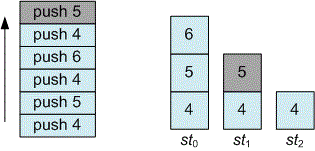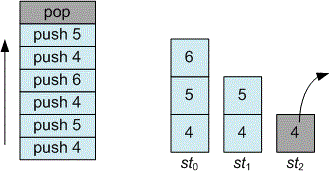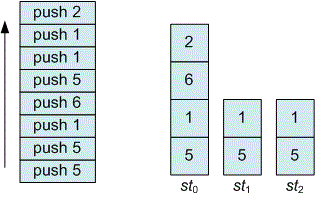Editorial
For each number we’ll store the number of times that it occurs in the stack. Let’s choose a map as a data structure for .
Declare an array of stacks vector<stack<int>> st. Here stores elements that occur on the stack times (the numbering of cells in the st array starts from zero). The order in which the elements are in matches the order in which they are pushed onto the stack.
Let the number be pushed to the stack for the -th time. If the element does not exist, then add (push_back) the element to the array. Then push to the top of the stack .

When you delete element, you must pop the item from the top of the last stack.

For example, if in the future there are only pop operations, then the elements from the stack will be removed in the following order: .
Example
Consider the order in which elements are pushed into array of stacks for the next example.

When removed, items will be popped from the stack in the following order: .
Algorithm realization
To work with the frequency stack, we declare the FreqStack class.
class FreqStack
{
public:Declare:
map , where contains the number of times an element occurs in the stack
• array of stacks ;
map<int, int> freq; vector<stack<int>> st;
The function push pushes the element to the stack.
void push(int x)
{
int f = freq[x];
freq[x] = f + 1;
if (f == st.size()) st.push_back(stack<int>());
st[f].push(x);
}The function pop pops element from the stack.
int pop()
{
int x = st.back().top();
st.back().pop();
if (st.back().empty()) st.pop_back();
freq[x]--;
return x;
}
};The main part of the program. Read the input data. Simulate the stack.
while (cin >> str)
{
if (str == "push")
{
cin >> n;
fs.push(n);
}
else // pop
cout << fs.pop() << endl;
}